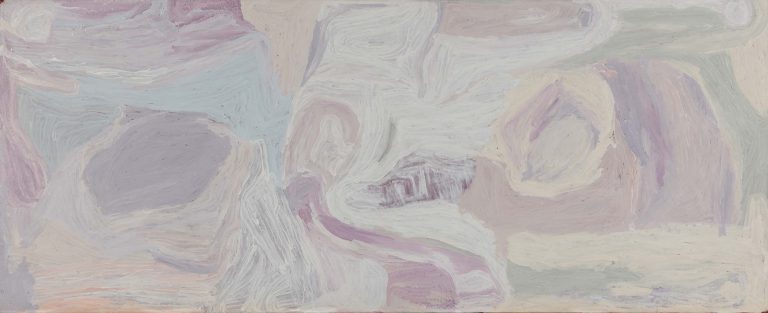We acknowledge the Traditional Owners of the land on which the Queensland Art Gallery | Gallery of Modern Art stands and recognise the creative contribution First Australians make to the art and culture of this country.

Nora Wompi / Kukatja people / Australia 1934–2017 / Kunawarritji 2011 / Synthetic polymer paint on Belgian linen / 300 x 120cm / Purchased 2014 in memory of Margaret Mittelheuser AM through the Queensland Art Gallery | Gallery of Modern Art Foundation / Collection: Queensland Art Gallery / © Nora Wompi/Licensed by Viscopy
Nora WompiKunawarritji 2011
On Display: QAG, Gallery 2
In Kunawarritji 2011, Nora Wompi has captured the metaphysical essence of her Kunawarritjii Tjukurrpa (Dreaming) rather than its physical features. Wompi says that, for her, Kunawarritji is the centre of it all. Gained through a lifetime of connection, she shares her perception of the underlying spiritual meaning of the site with us.
Her work is one of juxtaposition, progression, movement and experimentation, where she captures the continual static yet ever-changing landscape. Lines of tali (sand hills) and kila (circular rockholes) appear subliminally, more as a mirage than as material presences. The surface bears the texture left by the broad strokes of Wompi’s brush, giving form and movement.
Wompi has used a palette of muted whites with winter greens, plum purples, soft apricots and dusty pinks — reminiscent of the soft colourings of the landscape during the fading light of sun down. Tracey Griggs observes that:
. . . at first glance, these colours appear not to be those iconic desert colours, but looking closely at the landscape through Nora’s eyes, these hues often entice and encapsulate the visual. For in the numerous salt lakes that pattern the landscape, the whiteness of the salt is blinding within the sun’s beat, but as the sun sets, so does the landscape bask in softer tones of reds, pinks and purples.1
Endnotes:
1. Tracey G Griggs, ‘Nora Wompi: Her recent works’, in Nora Wompi at the Depo Gallery, Sydney: 15–26 November 2011 [exhibition catalogue], Suzanne O’Connell Gallery, Brisbane, 2011.
Nora Wompi (1934–2017) was born in the Great Sandy Desert at Lilbaru, close to Well 33 on the Canning Stock Route, where she lived a traditional nomadic life until her early twenties. Consistent with the nomadic ethos, there were long walks through the desert with her mother and brother, often in harsh conditions, including to Billiluna Station and on to Balgo Mission.
She eventually lived with her third husband, Dick Cowboy, in Fitzroy Crossing where they painted together until he passed away. Wompi then returned to Well 33, but maintained a highly transitory lifestyle, moving freely between Kunawarritji, Balgo, Kiwirrkurra and Punmu to visit family members and paint.
As well as expressing her deep cultural knowledge in her works, Wompi also tells of recent histories, which, during her lifetime, brought European settlers into the world of the Kukatja people.